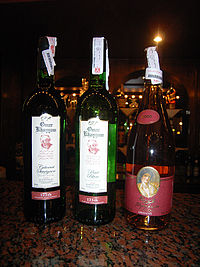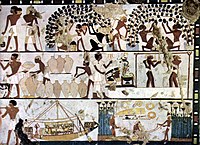Egyptian wine

Winemaking has a long tradition in
Climate

High average temperatures and poor rainfall present a major challenge for Egyptian grape producers. To overcome these difficulties vineyards in Egypt apply innovative solutions, such as using pergolas to shade the plants and palm trees to shield them from winds as well as transporting the harvest in refrigerated trucks.[4]
Before the construction of the
Grape varieties
At the time the state-owned Al Ahram Beverages Company was privatized in 1997 all noble grapes that had previously been planted by its subsidiary, Gianaclis Vineyards, were lost. This meant that grapes had to be imported, mainly from Lebanon. This coincided with a boom in the tourism industry which meant wineries had to produce cheap wine in large quantities to meet the surging demand from Western tourists. Due to the lack of locally produced wine grapes wineries imported concentrated juice from Europe which would be diluted with water and fermented, contributing to the negative reputation of Egyptian wine.[2] The Gianaclis Vineyards started planting vines again in 2004 in Alexandria and Luxor. By 2010 only 2% of their wines were made with Lebanese grapes, with Egyptian grapes used for the remainder of their production.[6] The industry has in recent years started experimenting with international varieties to find grapes that are suited for the Egyptian climate.[5] The main varieties used in red wines are Cabernet Sauvignon, Syrah, Grenache, Bobal and Tempranillo, while Viognier, Chardonnay and Muscat are used for white wines.[7]
Koroum of the Nile, a winery based in
History


Wine was a staple commodity in
Wine in ancient Egypt was predominantly
Residue from five clay amphoras in Tutankhamun's tomb, however, have been shown to be that of white wine, so it was at least available to the Egyptians through trade if not produced domestically.[13]
Winemaking continued to be part of Egyptian culture during Roman rule in Egypt. Christians constituted the majority of Egypt’s population by the 3rd century, despite a reserved attitude towards alcohol in the Church of Alexandria monasteries are known have stored and produced large quantities of wine.[14] In 2008 two wine presses dating back to Roman rule in Egypt were unearthed near Saint Catherine's Monastery in Sinai, along with ancient coins from Antioch, which could indicate that Egyptian wine was exported to Christians in the region.[15]
The production of wine declined significantly after the
See also
References
- ^ Turtle, Michael (30 May 2014). "Reviving the Nectar of Ancient Egypt". Time Travel Turtle. Retrieved 7 November 2016.
- ^ a b Furer, David. "Egyptian wine on the way up – Hot climate viticulture is spreading". BKWineMagazine. Retrieved 12 November 2016.
- ^ "Wine production (tons)". Food and Agriculture Organization. 6 October 2015. p. 1. Retrieved 12 October 2016.
- ^ Jean-Baptiste, Ancelot (27 June 2014). "Egypt: the vineyards behind the pyramids". the drinks business.
- ^ a b "A Vineyard in Egypt". Maadi Messenger. Archived from the original on 21 December 2017. Retrieved 8 November 2016.
- ^ Ramadan, Ahmed (2010). "Wine-making in the Middle East: Egypt". Egypt Independent. Retrieved 12 November 2016.
- ^ "Egyptian Wine Regions". wine-searcher. Retrieved 12 November 2016.
- ^ "Egypt wineries beat the desert and poor reviews to win awards". Middle East Eye. Retrieved 13 November 2016.
- ^ "Selling Egypt's wine to the world". Japan Times. Archived from the original on 15 November 2016. Retrieved 12 November 2016.
- ^ ISBN 978-1-009-27895-9
- ^ Maria Rosa Guasch-Jané, Cristina Andrés-Lacueva, Olga Jáuregui and Rosa M. Lamuela-Raventós, The origin of the ancient Egyptian drink Shedeh revealed using LC/MS/MS, Journal of Archaeological Science, Vol 33, Iss 1, Jan. 2006, pp. 98–101.
- ^ "Isis & Osiris". University of Chicago.
- ^ White wine turns up in King Tutankhamen's tomb. USA Today, 29 May 2006.
- ISBN 9783161541728.
- ^ Bossone, Andrew. "Ancient Christian "Holy Wine" Factory Found in Egypt". National Geographic. Archived from the original on November 7, 2016. Retrieved 6 November 2016.
- ^ a b c Lewicka, Paulina (2005). Restaurants, Inns and Taverns That Never Were: Some Reflections on Public Consumption in Medieval Cairo. BRILL. pp. 71, 66, 85.
{{cite book}}:|periodical=ignored (help) - ISBN 9789004194724.
- ^ "Gianaclis: The History and Heritage of Gianaclis Wines in Egypt". Cairo 360. Retrieved 7 November 2016.
- ^ a b c Teeter, Adam. "The Non-Alcoholic Beer That Fueled American Pharoah's Triple Crown Victory". Vinepair. Retrieved 7 November 2016.
- ^ "About ABC - History". Al Ahram Beverages. Retrieved 7 November 2016.
